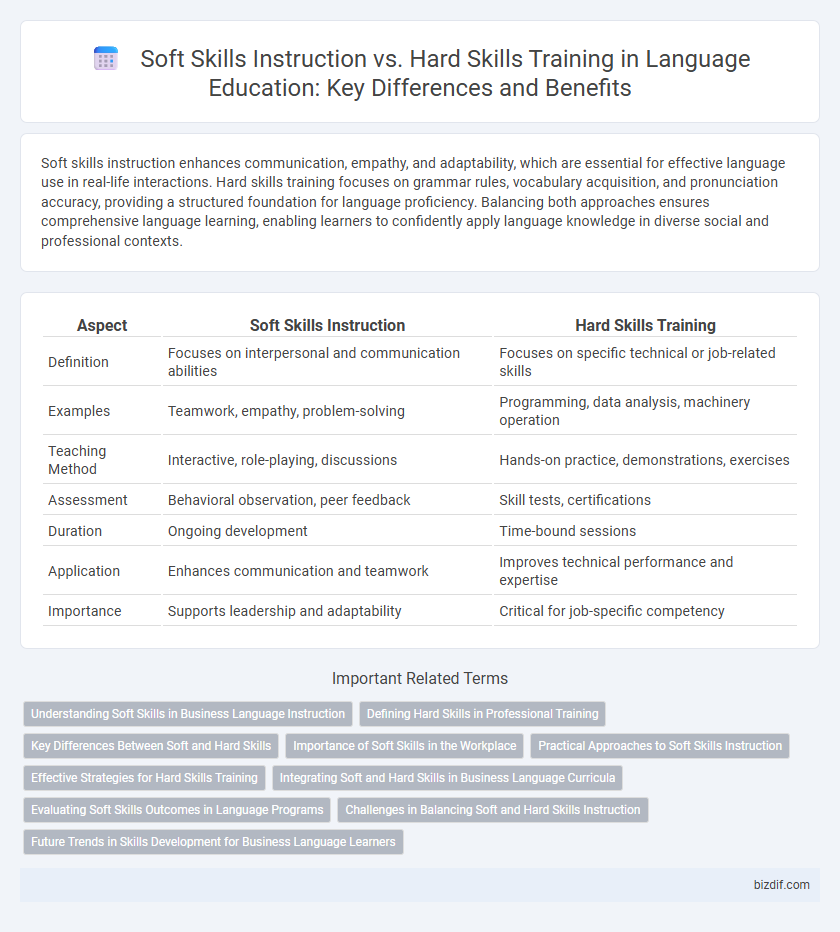Soft skills instruction enhances communication, empathy, and adaptability, which are essential for effective language use in real-life interactions. Hard skills training focuses on grammar rules, vocabulary acquisition, and pronunciation accuracy, providing a structured foundation for language proficiency. Balancing both approaches ensures comprehensive language learning, enabling learners to confidently apply language knowledge in diverse social and professional contexts.
Table of Comparison
| Aspect | Soft Skills Instruction | Hard Skills Training |
|---|---|---|
| Definition | Focuses on interpersonal and communication abilities | Focuses on specific technical or job-related skills |
| Examples | Teamwork, empathy, problem-solving | Programming, data analysis, machinery operation |
| Teaching Method | Interactive, role-playing, discussions | Hands-on practice, demonstrations, exercises |
| Assessment | Behavioral observation, peer feedback | Skill tests, certifications |
| Duration | Ongoing development | Time-bound sessions |
| Application | Enhances communication and teamwork | Improves technical performance and expertise |
| Importance | Supports leadership and adaptability | Critical for job-specific competency |
Understanding Soft Skills in Business Language Instruction
Understanding soft skills in business language instruction involves emphasizing communication, emotional intelligence, and cultural awareness to enhance workplace interactions. Unlike hard skills training, which targets technical competencies, soft skills instruction focuses on developing interpersonal abilities that drive collaboration and leadership effectiveness. Integrating soft skills into language learning equips professionals to navigate complex business environments with empathy and adaptability.
Defining Hard Skills in Professional Training
Hard skills in professional training refer to specific, teachable abilities such as technical proficiency, coding, data analysis, and machinery operation that can be quantified and measured. These skills are essential for performing particular job functions and are often acquired through formal education, vocational courses, or on-the-job training. Mastery of hard skills enables employees to fulfill role-specific tasks efficiently and contributes directly to organizational productivity.
Key Differences Between Soft and Hard Skills
Soft skills instruction emphasizes interpersonal abilities such as communication, teamwork, and emotional intelligence, which are essential for effective collaboration and leadership. Hard skills training focuses on specific technical competencies, like coding, data analysis, or machinery operation, that require measurable and teachable expertise. The key differences lie in their application: soft skills enhance personal and social interactions, while hard skills involve concrete, job-specific tasks and procedures.
Importance of Soft Skills in the Workplace
Soft skills such as communication, teamwork, and problem-solving play a crucial role in enhancing workplace productivity and employee engagement. Unlike hard skills that focus on technical expertise, soft skills improve interpersonal relationships and leadership effectiveness. Employers increasingly prioritize soft skills development to foster collaboration and adapt to dynamic professional environments.
Practical Approaches to Soft Skills Instruction
Effective soft skills instruction prioritizes experiential learning methods such as role-playing, group discussions, and real-world simulations to enhance communication, teamwork, and problem-solving abilities. Utilizing feedback loops and reflective exercises fosters self-awareness and continuous personal development. Integrating these practical approaches within language instruction ensures learners develop essential interpersonal competencies alongside linguistic proficiency.
Effective Strategies for Hard Skills Training
Effective strategies for hard skills training emphasize hands-on practice, real-world simulations, and technology integration to enhance technical expertise and precision. Utilizing competency-based assessments and personalized learning paths ensures skill mastery aligned with industry standards. Incorporating multimedia resources and adaptive learning technologies accelerates knowledge retention and practical application.
Integrating Soft and Hard Skills in Business Language Curricula
Integrating soft skills such as communication, teamwork, and problem-solving with hard skills like technical vocabulary and industry-specific terminology enhances business language curricula by fostering both interpersonal effectiveness and professional competency. Tailoring instruction to blend language proficiency with emotional intelligence and critical thinking equips learners to navigate complex workplace scenarios confidently. This comprehensive approach improves overall workplace communication, driving productivity and collaboration in global business environments.
Evaluating Soft Skills Outcomes in Language Programs
Evaluating soft skills outcomes in language programs requires qualitative assessments such as behavioral observations, peer feedback, and self-reflections to capture interpersonal communication, empathy, and adaptability. Unlike hard skills training, which relies on quantifiable tests and proficiency scores, soft skills measurement involves dynamic criteria including collaboration and cultural sensitivity demonstrated through role-playing or real-life interactions. Integrating multisource evaluations enhances the accuracy of assessing linguistic soft skills growth critical for effective language instruction success.
Challenges in Balancing Soft and Hard Skills Instruction
Balancing soft skills instruction with hard skills training presents challenges such as allocating sufficient time and resources to both areas without compromising depth and quality. Soft skills, including communication, teamwork, and adaptability, require experiential learning and continuous reinforcement, whereas hard skills demand technical proficiency and structured practice. Integrating these distinct instructional approaches necessitates tailored curricula and assessment methods to ensure learners develop a cohesive skill set aligned with workplace demands.
Future Trends in Skills Development for Business Language Learners
Future trends in business language learners emphasize an integrated approach combining soft skills instruction with hard skills training to enhance communication and technical proficiency. Adaptive learning technologies and AI-driven platforms personalize skill development, catering to dynamic workplace demands and multicultural environments. Emphasizing intercultural competence, emotional intelligence, and digital literacy alongside language proficiency prepares learners for collaborative global business contexts.
Soft Skills Instruction vs Hard Skills Training Infographic

 bizdif.com
bizdif.com